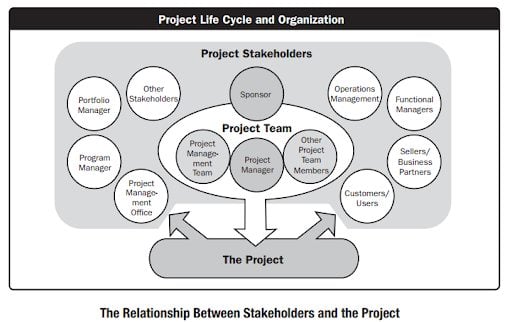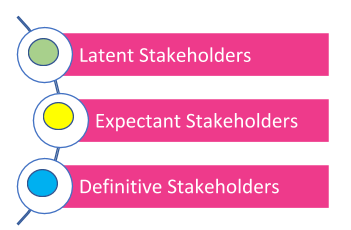Analyze your Project's Stakeholders with the help of the Salience Model
Introduction
Managing the stakeholders’ expectations is an important factor in the success of a project. Due to the crucial impact stakeholders can have on projects, Stakeholder Management is an important component of Project Management.
There can be many stakeholders in a project. Small projects have a smaller number of stakeholders. This makes it easy to manage. On the other hand, large projects have many stakeholders. This makes it difficult to manage.
In a real-world scenario, you will not be able to treat every stakeholder equally. Every stakeholder has different requirements and expectations. We need to manage these requirements and expectations. So, first, you need to identify and classify your project stakeholders.
Classifying stakeholders is a critical process. Here you separate stakeholders as per their power, interest, urgency, etc. After classification, you will develop your stakeholder management strategy
The PMBOK Guide describes four models to classify stakeholders:
1. Power/interest grid
2. Power/influence grid
3. Influence/impact grid
4. Salience model
The first three models use two attributes and are similar. The salience model PMP uses three attributes. We will study the salience model to classify project stakeholders.
Stakeholders
What does stakeholder salience mean?
Stakeholder salience is the degree to which the stakeholders are visible, vocal, and important to a project. It is an important aspect of stakeholder management. It is common for highly vocal stakeholders to try and define requirements and make decisions beyond their expertise and authority. This often leads to issues.
Let us see who stakeholders can be and get some understanding in this area.
A stakeholder can be an individual, a group, or an organization. A stakeholder may affect, be affected by, or perceive itself to be affected by a decision, activity, or outcome of a project. Stakeholders may have interests that may be positively or negatively affected by the project.
They may or may not be actively involved in the project. Stakeholders may also exert influence over the project, its deliverables, and the project team to achieve a set of outcomes that satisfy strategic business objectives or other needs.
Stakeholders include all members of the project team as well as all interested entities. They can be are external or internal to the organization. The project team identifies internal and external, positive and negative, and performing and advising stakeholders. This helps them determine the project requirements and the expectations of all parties involved. The project manager should manage the influences of these various stakeholders. The project manager should consider the project requirements and the right type of project management to ensure a successful outcome. The figure below illustrates the relationship between the project, the project team, and various stakeholders.

Stakeholders have varying levels of responsibility and authority when participating in a project. This level can change over the course of the project’s life cycle. Their involvement may range from occasional contributions in surveys and focus groups to full project sponsorship. This includes providing financial, political, or other support. Some stakeholders may also detract from the success of the project, either passively or actively. These stakeholders require the project manager’s attention throughout the project’s life cycle.
Stakeholder identification is a continuous process throughout the entire project life cycle. Identifying stakeholders, understanding their relative degree of influence on a project, and balancing their demands, needs, and expectations are critical to the success of the project. Failure to do so can lead to delays, cost increases, unexpected issues, and other negative consequences including project cancellation
The following are some examples of project stakeholders:
Sponsor: A sponsor is a person or group who provides resources. He supports the project and is accountable for enabling success. The sponsor may be external or internal to the project manager’s organization.
Customers and users: Customers are the persons or organizations who will approve and manage the project’s product, service, or result. Users are the persons or organizations that will use the project’s product, service, or result.
Sellers: Sellers are also called vendors, suppliers, or contractors. They are external companies that enter into a contractual agreement. They provide components or services necessary for the project.
Business partners: Business partners are external organizations. They have a special relationship with the enterprise. It may be through a certification process. Business partners provide specialized expertise or fill a specified role such as installation, customization, training, or support.
Organizational groups: Organizational groups are internal stakeholders who are affected by the activities of the project team.
Functional managers: Functional managers are key individuals who play a management role within an administrative or functional area of the business, such as human resources, finance, accounting, or procurement.
Other stakeholders: Additional stakeholders, such as procurement entities, financial institutions, government regulators, subject matter experts, consultants, and others, may have a financial interest in the project, contribute inputs to the project, or have an interest in the outcome of the project.
Salience Model: Salience means “the quality of being particularly noticeable, important or prominent.” So, stakeholder salience means the importance/prominence of a stakeholder.
Stakeholder salience can be defined as the “degree to which managers give priority to competing stakeholders’ claims in their decision-making process.”
The stakeholder salience model was proposed by Ronald K. Mitchell, Bradley R. Agle, and Donna J. Wood in 1997.
Here, a stakeholder has three attributes:
1. Power
2. Legitimacy
3. Urgency
Power: Power is the influence or authority of the stakeholder on your project or its objectives. Focus on stakeholders with high power. These stakeholders are fewer in number.
Legitimacy: Legitimacy is how genuinely involved a stakeholder is with your project. You should not spend your time on a stakeholder who doesn’t have a legitimate interest. Pay attention to stakeholders with legitimate claims.
Urgency: Urgency is the degree to which stakeholder requirements call for immediate attention. Urgency depends on two factors: time-sensitivity and criticality. You need to find out whether any requirement is time-specific or if mere fulfillment is important.
Identify your project stakeholders and assign them attributes. After that, prioritize stakeholders according to their attributes. Based on this ranking you will develop the stakeholder’s management strategy. This will save time and help you win stakeholders’ support.
Stakeholder salience is not static; it is dynamic and can change during the project life cycle. Ensure you keep updating the stakeholder register to reflect the changes.
Stakeholders in the Salience Model
A stakeholder salience model diagram is a Venn diagram comprising of three attributes. These are represented by three circles. Attributes are power, legitimacy, and urgency. The intersection of circles shows stakeholders with multiple attributes.
-2.png)
Based on these attributes, you can classify stakeholders into seven groups.
1. Dormant
2. Discretionary
3. Dominant
4. Dangerous
5. Core
6. Dependent
7. Demanding
To develop your strategy, you divide these groups into three categories:



These stakeholders have low legitimacy, high power, and low urgency. Being high power, they can impact your project. So, they need to be managed carefully. A stakeholder from top management does not take part in meetings. He has no interest in your project. However, you will still watch this stakeholder as they have power and you never know when they will change their mind.

These stakeholders have high legitimacy, low urgency, and low power. Although they have low power and low urgency, you will fulfill their requirements because of their legitimacy. NGOs or charitable organizations are examples of discretionary stakeholders. They do not have power or urgency, but they are legitimate stakeholders.

These stakeholders have high urgency, low power, and low legitimacy. They are usually vocal and can influence other stakeholders if their requirements are not met. These stakeholders want attention. These need to be managed carefully. For example, your project is in a public place, and residents from the neighborhood show interest in your project and ask for information.

These stakeholders have two attributes: they have expectations of the project and are active.
Some examples of expectant stakeholders are dominant, dangerous, and dependent.

These stakeholders have high legitimacy and high power but low urgency. As these stakeholders have a legitimate interest in your project, you will manage them closely. Since the urgency is low, their rank is below the core group. For example, you are constructing a building where local authorities are stakeholders. Though they don’t have urgent issues with your project, you will manage them closely as they have both power and legitimacy.
.png)
These stakeholders have high power, and high urgency but low legitimacy, and this makes them vulnerable. They can be violent and can create trouble for your project. You will manage them cautiously. For example, suppose you are working in a remote area of a third world country, and in this case, a group of local terrorists can act as dangerous stakeholders. The security of your team members is paramount. You must identify these stakeholders and mitigate the threats they pose.

These stakeholders have high legitimacy, high urgency but low power. Since these stakeholders have little power, you will not pay as much attention. For example, if you are doing construction work in a public place, local residents can be an example of dependent stakeholders. You will keep a watch on these stakeholders because of their legitimacy and high urgency. They may form a group or associate with powerful stakeholders. This can create trouble for you if their requirements are not met.

These stakeholders have three attributes and require the most attention. You will manage these stakeholders closely. An example of definitive stakeholders is “core.”


These are not stakeholders of your project, so you will not manage these people.
Strategy to Manage Stakeholders
You will manage your stakeholders as follows:
You will give the highest priority to the core group because this group has all the attributes.
The next highest priority should be given to dominant, dangerous, and dependent stakeholders because they have a mix of any two attributes.
The lowest priority group consists of discretionary, demanding, and latent because they have one attribute. You will give little importance to these stakeholders but observe them because you never know when they will change their salience.
Changes in Stakeholders’ Attributes
The project environment is dynamic, so you will continuously get new stakeholders and lose old ones. Stakeholders’ attributes can change as the project progresses. A powerless stakeholder may become powerful, and an illegitimate stakeholder may become a legitimate one. You should update your stakeholder management strategy to reflect the changes in stakeholders’ attributes.
Benefits and Challenges
Let us take a look at the benefits and drawbacks that come with using the Salience Model.
Benefits of the Salience Model
The benefits of the salience model are:
It helps identify the stakeholder’s interests
Potential risks and misunderstandings are known
Helps make mechanisms to positively influence other stakeholders
Helps control negative stakeholders as well as their adverse effects on the project
It provides you with better insight into your stakeholders.
It helps you to save resources, time, and effort.
It helps complete projects with minimal obstruction.
Challenges of the Salience Model
The salience model has the following limitations:
This model requires more time and effort
It takes a lot of resources and time to monitor three attributes continuously
Bias in opinion can influence its effectiveness and hence this is a subjective procedure.
This model assumes attributes are present or absent, though, they may vary between these two.
Conclusion
The salience model helps you manage your stakeholders effectively. While more time consuming than the other models, However, it provides you with better analysis and understanding of your stakeholders. This model lets you focus your energy on important stakeholders. It keeps you from wasting your time on less important ones.
Check out our project management courses!